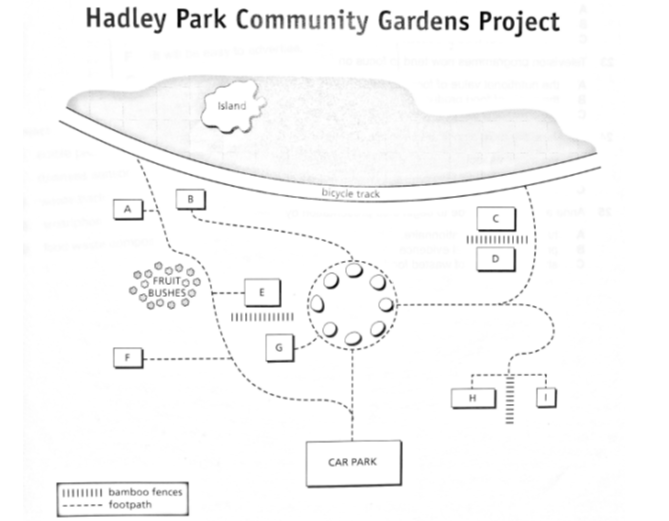SECTION 1
Questions 1-6
Complete the table below. Write NO MORE THAN ONE WORD OR A NUMBER.

Questions 7-10
Complete the sentences below. Write ONE WORD ONLY for each answer.
7. The watercolours class suits people who are …………………
8. To find out about the Maori language class, contact Jason …………………
9. For the photography class, check the ………………… for the camera.
10. There is a trip to a local …………………in the final week of the photography class.
SECTION 2
Questions 11 and 12
Choose TWO letters A-E.
Which TWO tasks will the volunteers in group A be responsible for?
A. widening pathways
B. planting trees
C. picking up rubbish
D. putting up signs
E. building fences
Questions 13 and 14
Choose TWO letters A-E.
Which TWO items should volunteers in group A bring with them?
A. food and water
B. boots
C. gloves
D. raincoats
E. their own tools
Questions 15-20
Label the plan below. Write the correct letter A-I next of questions 15-20.
15. Vegetable beds …………………
16. Bee hives …………………
17. Seating …………………
18. adventure playground …………………
19. Sand area …………………
20. Pond …………………
SECTION 3
Questions 21-25
Choose the correct letter; A, B or C

Food Waste
21. What point does Robert make about the 2013 study in Britain?
A. It focused more on packaging than wasted food.
B. It proved that households produced more waste than restaurants.
C. It included liquid waste as well as solid waste.
22. The speakers agree that food waste reports should emphasise the connection between carbon dioxide emissions and
A. food production.
B. transport of food to landfill sites.
C. distribution of food products.
23. Television programmes now tend to focus on
A. the nutritional value of food products.
B. the origin of food products.
C. the chemicals found in food products.
24. For Anna, the most significant point about food waste is
A. the moral aspect.
B. the environmental impact.
C. the economic effect.
25. Anna and Robert decide to begin their presentation by
A. handing out a questionnaire.
B. providing statistical evidence.
C. showing images of wasted food.
Questions 26-30
What advantage do the speakers identify for each of the following projects?
Choose FIVE answers from the box and write the correct letter, A-G, next to Questions 26-30.
Advantages
A. it should save time
B. it will create new jobs
C. it will benefit local communities
D. it will make money
E. it will encourage personal responsibility
F. it will be easy to advertise
G. it will involve very little cost
Projects
26. edible patch …………………
27. ripeness centre …………………
28. waste tracking technology …………………
29. smartphone application …………………
30. food waste composting …………………
SECTION 4
Questions 31-40
Complete the notes below. Write ONE WORD for each answer.
Kite making by the Maori people of New Zealand
Making and appearance of kites
• The priests who made the kites had rules for size and scale
• (31) …………………was not allowed during a kite’s preparation
Kites:
• Often represented a god, a bird or a (32) …………………
• Had frames that were decorated with grasses and (33) …………………
• Had a line of noisy (34) …………………attached to them.
• Could be triangular, rectangular or (35) …………………shaped.
• Had patterns made from clay mixed with (36) ………………… oil.
• Sometimes had human head masks with (37) …………………and a tattoo.
Purpose and function of kites:
• A way of sending (38) ………………… to the gods
• A way of telling other villages that a (39) ………………… was necessary
• A means of (40) ………………… if enemies were coming.
ANSWER
1. 7.30
2. pencils
3. top
4. August
5. instructions
6. 55
7. beginners
8. Kahui
9. battery
10. show
11. B
12. E
13. B
14. C
15. G
16. I
17. B
18. E
19. C
20. A
21. C
22. A
23. B
24. C
25. A
26. G
27. A
28. D
29. C
30. E
31. food
32. hero
33. feathers
34. shells
35. diamond
36. shark
37. teeth
38. messages
39. meeting
40. escape
